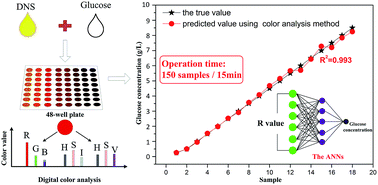A novel digital color analysis method for rapid glucose detection†
Abstract
The spectrophotometer is the most used analysis equipment in traditional colorimetric methods. However, the operation of using a spectrophotometer is time-consuming and labor-intensive, which presents practical difficulties in rapid detection. To this end, we present a digital color analysis method, using the typical 3,5-dinitrosalicylic acid (DNS) method for glucose detection as an example. The primary colors from 3 color spaces (Red-Green-Blue, Hue-Saturation-Value, Hue-Saturation-Intensity) were studied as quantitative analytical parameters for the glucose concentration and the red color (from the Red-Green-Blue colorspace) of the assay image provides superior prediction precision (>99.8%). Combined with the color analysis, two calculation algorithms, nonlinear regression and artificial neural networks, were compared for the detection of a high concentration of glucose. Then a microtiter plate (48-well plate) platform, based on the color analysis, was set up. Compared to existing methods using a spectrophotometer, the digital color analysis method has a large detection range (0–10 g L−1), high accuracy (0.07 g L−1) and fast detection rate (150 samples detected within about 15 min). It also shows great promise for use in a variety of reducing sugar measurements such as xylose, fructose and maltose. These aforementioned features render this newly developed method highly suitable for quick detection applications.


 Please wait while we load your content...
Please wait while we load your content...